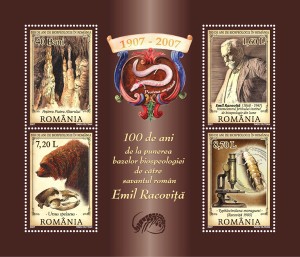 On the occasion of celebrating one century from the foundation of biospeleology by the wide-world recognized great Romanian scientist, Emil Racoviţă, Romfilatelia, the specialized company in editing and trading Romanian postage stamps, introduces into circulation the postage stamps issue 100 YEARS
On the occasion of celebrating one century from the foundation of biospeleology by the wide-world recognized great Romanian scientist, Emil Racoviţă, Romfilatelia, the specialized company in editing and trading Romanian postage stamps, introduces into circulation the postage stamps issue 100 YEARS
SINCE THE FOUNDATION OF BIOSPELEOLOGY BY THE ROMANIAN SCIENTIST EMIL RACOVIŢĂ.On the occasion of celebrating one century from the foundation of biospeleology by the wide-world recognized great Romanian scientist, Emil Racoviţă, Romfilatelia, the specialized company in editing and trading Romanian postage stamps, introduces into circulation the postage stamps issue 100 YEARS
SINCE THE FOUNDATION OF BIOSPELEOLOGY BY THE ROMANIAN SCIENTIST EMIL RACOVIŢĂ.
The Romanian speleologist and biologist Emil Racoviţă was born in Iaşi, on the 15th of November 1868. His passion for the natural sciences was aroused by the professor Grigore Cobãlcescu, during he studied at the “United Institutes” high school of Iaşi. Fulfilling at first his father’s wish, Emil Racoviţă followed the Law Faculty of Paris, which he gave up in favour of the vocation he was destined for. Thus, the young Racoviţă graduated the Sciences Faculty of Sorbonne, having the famous scientist Henri de Lacaze-Duthiers as Zoology professor.
In 1896, Racoviţă became famous among the European scientists, obtaining the doctor title, with a remarkable piece of work (Le lobe céphalique et l’encéphale des anélides polychètes – Paris).
During the period 1897-1899 that he spent together with Amundsen aboard the “Belgica” ship, within the Belgian Antarctic Expedition, Racoviţă gathered 1600 zoological and botanical specimens. This collection allowed him to publish, on his return, an important work on cetaceans. On the 1st of November 1900, he became deputy manager of the “Arago” Oceanological Laboratory of Banyuls-sur-Mer, France, founded 20 years before. In 1904, Racoviţă made a crucial discovery, which was going to influence the rest of his life. The new species of crustaceans, found in the Cueva del Drach
cave of Mallorca, fascinated him to such an extent that he would give up to the oceanological research in order to dedicate himself to the underground ecosystems. The publication of his work “Essay on biospeleological problems”, in 1907, marked the birth of biospeleology, which he defined as the science of life forms from the underground environment (caves and underground waters).
In 1920, he returns to Romania to found, in Cluj, the first Speleological Institute of the world, where he remained director until 1947. One of his important work is “Speleology”, published in 1927.
Emil Racoviţă was also President of the Romanian Academy (1926-1929), and later, between 1929 and 1930, he was appointed Rector of the Cluj University, where he taught the first course of general speleology of Romania. The work “Evolution and its problems”, published in 1929, approaches in a very original way the evolutionist theory, developing a phylogenetic and systematic perspective on the evolution of underground animals. By closely pursuing his aim to understand the natural history of the underground environment, he obtained remarkable results due to his biospeleology program: he explored 1200 caves in Europe and Africa, he gathered a collection of 5000 underground animals, and published over 66 works on the underground fauna, totaling almost 6000 pages.
The scientist Emil Racoviţă died in 1947, at the age of 79, before reorganizing the Cluj Institute. Great lover of nature, Emil Racoviţă is one of the initiators of the protection of natural monuments of Romania.
The postage stamp having the face value of RON 0.40 illustrates the inside of the Altar Rock cave of Bihorului Mountains.
The postage stamp having the face value of RON 1.60 presents Emil Racoviţă, the founder of the first Biospeleology Institute of the world.
The postage stamp having the face value of RON 7.20 represents the skull and the reproduction of the image of the Ursus spelaeus species.
The postage stamp having the face value of RON 8.70 represents a crustacean (Typhlocirolana moraguesi), discovered by Emil Racoviţă in 1905, in the sweet water lake of the Devil Cave, in the Mallorca-Baleare Island.
The image on the First Day Cover illustrates the most famous and rare vertebrate adapted to cave life. It is blind and depigmented. It lives in certain caves in the Dinaric Alps.
Issue date: 2007-01-19


